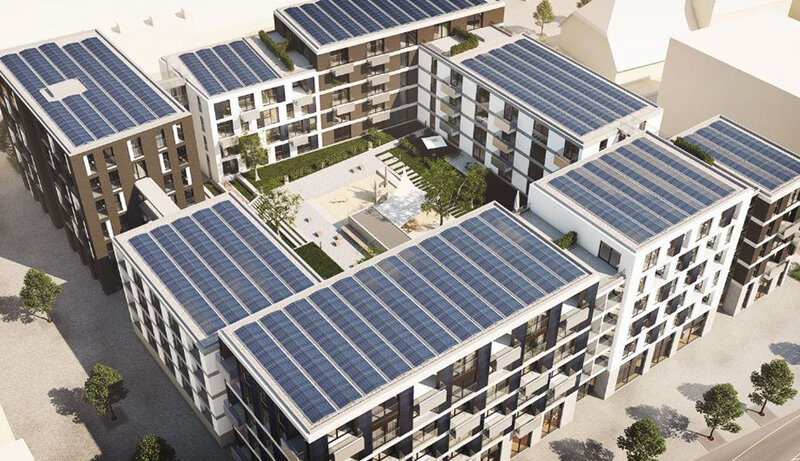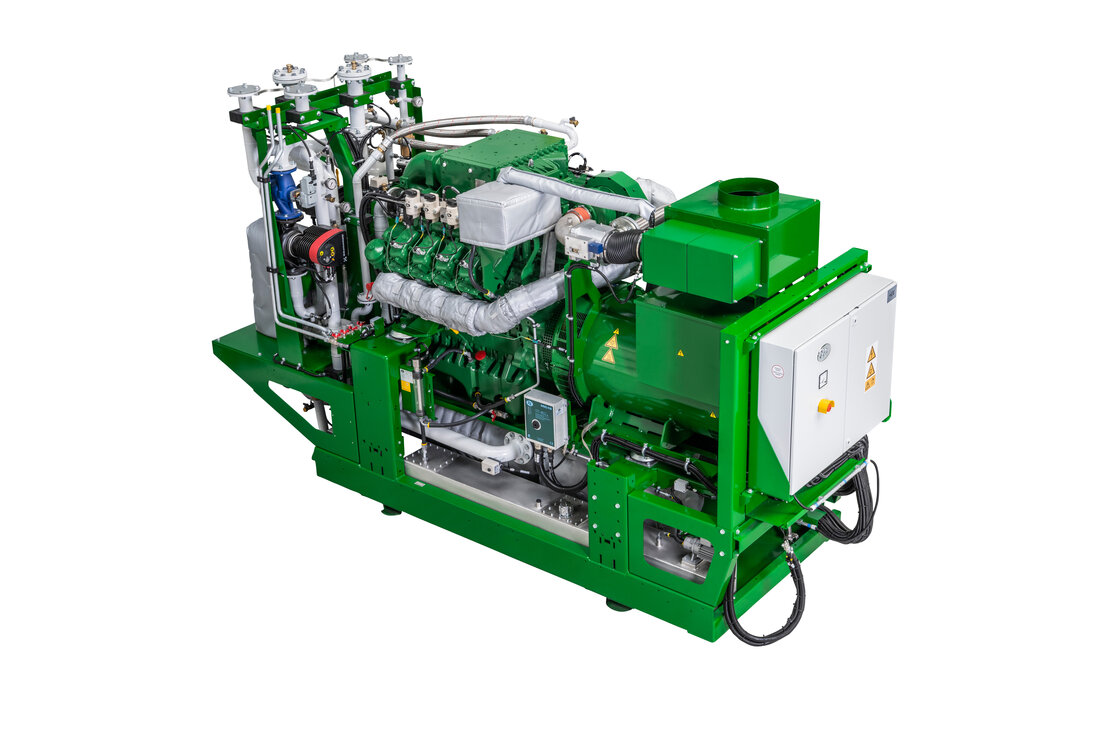District supply of the future
Climate-neutral and low-cost in Esslingen, Germany
Facts & figures

The district supply of the future is climate-neutral – and low-cost. Although this may sound visionary, it is currently becoming reality in the “Neue Weststadt” district (also known as LOK.West) in Esslingen on the river Neckar, Germany. There, city planners and energy experts are implementing a concept to act as a blueprint for an ecological and economical city district supply. Electricity and heat for the district comes from green energy and local storage which provides a high degree of independence and flexibility.
Over 500 apartments, some shops, a high-rise office block with twelve stories and a campus for around 1,800 students will be located on the site on the Neckar after completion. The first office buildings in the south of the site have already been built and occupied, the rest will be completed by 2022.
Affordable climate protection
The things that make the energy concept of the Neue Weststadt district so special are:
- the focus on low-cost, sustainable supply,
- the simultaneous planning of generation and consumer plants,
- the holistic consideration of the electricity and heat sectors, incorporating mobility.
The focus is on reducing the energy consumption significantly and covering the remaining requirements in a climate-neutral way. So it’s not a matter of exploiting every energy-saving opportunity – that makes climate protection affordable. The use of renewable energy to cover the remaining requirements secures the climate-neutral approach and represents more value for money in the long term than reducing consumption through expensive energy saving measures.
A mix of energy sources or plants and energy stores is required for implementation. The electricity comes from local, roof-mounted photovoltaic plants (PV) or is purchased as green electricity. Heat is produced with eco gas or – indirectly, as outlined in more detail below – also from green electricity.
Batteries store surplus electricity and the fields of electricity and heat are connected. But, while other concepts achieve this link through Power-to-Heat with electric heating bars or heat pumps, the sectors are merged in a different way with the energy plant for residential block D with 167 residential units, the office block and the university building.
Local sector coupling with green hydrogen
The new energy plant produces green hydrogen from renewable electricity with an electrolyzer installed underground. This forms a “gas store”, which decouples the power generation and power consumption, as the gas can be “fed back” into a combined heat and power plant (CHP) with a time delay. The heat generated during operation of the CHP flows into the district heating grid. The electrolyzer is another heat source. It produces so much waste heat at approx. 55 °C that it can cover the basic requirement for heating and hot water preparation.
Electricity, heat, mobility – everything becomes one
The “Power-to-Greengas-to-Power&Heat” energy conversion is more complex than the use of electrical power for heat pumps or heating elements, but the concept is probably also more versatile and promising. There̕s a reason why the Neue Weststadt district project is funded by the Federal Ministry for Economic Affairs and Energy (BMWi) and the Federal Ministry of Education and Research (BMBF) as part of the “Solar building/energyefficient city” funding priority.
Hydrogen offers advantages for the energy system
Prof. Dr.-Ing. Manfred Norbert Fisch from the Steinbeis-Innovationszentrum Energie-, Gebäude- und Solartechnik (EGS) highlighted the potentials of sector coupling with green hydrogen in a press release of the city of Esslingen. The goal is to “demonstrate the function and suitability for everyday use of hydrogen production with all its advantages for the energy system, including on district level”.
The hydrogen storage can decouple local electricity production from energy consumption, and it can serve the grid by, for example, compensating for electricity oversupply or undersupply, or by working with batteries to reduce the amount of PV electricity fed into the grid when there is a threat of grid overload.


Effective marketing of green hydrogen
“We can’t set up a large seasonal store for hydrogen for space reasons”, explains Manuel Thielmann, expert for decentral energy supply at Polarstern GmbH in Munich. His team created the innovative energy concept for the Neue Weststadt district. “Surplus hydrogen is therefore fed into the natural gas grid or sold to the industry.” In the future, a portion will also be used for transport. A hydrogen fuel station is already planned.
CHP is more economical than a fuel cell
The primary goal, however, is to use hydrogen onsite. To ensure that the reconversion takes place at affordable prices, the responsible parties preferred the motorized hydrogen CHP. Thielmann explains why: “Although a fuel cell converts a higher proportion of the energy contained in the gas into electricity, the costs per installed kilowatt are much higher than with a motorized CHP. And we couldn’t purchase a fuel cell of this performance class from Europe.”
The CHP heat can be used well onsite, meaning that a higher total efficiency can be achieved, says Thielmann. “We don’t just look at the efficiency of the power supply, but optimize the energy system as a whole.”
Cold from heat increases the annual efficiency
Efficient heat usage is also achieved through the fact that the cold for the air conditioning in the university building and the office block is also produced using heat: an absorption chiller will effectively convert the waste heat from the CHP system, which is generated at a high temperature level, into cooling energy and will complete the reverse power generation plant to create an attractive combined heat, power and cooling system.
CHP from 2G works with 100% hydrogen
Once the decision was made in favour of the combined heat and power plant over the fuel cell, the choice of supplier was easy. “There’s only one manufacturer in Europe offering CHPs with the right powers and that can be operated with 100% hydrogen,” reports Thielmann, referring to 2G Energy. The CHPs could also work with a hydrogen-eco gas mixture or pure eco gas, so that operation is also possible if the electrolyzer fails. “Another argument in favor of 2G is that the manufacturer can already demonstrate operating experience with pure hydrogen, for example in a project in Haßfurt,” the energy expert continues.
Commissioning of the CHP in spring 2021
The CHP from 2G, an agenitor 406, is due to be commissioned in the Neue Weststadt district in spring 2021. A sound insulation capsule will mean that the operating noise of the engine won̕t be heard in the neighboring residential properties. With hydrogen as a fuel, the CHP supplies around 150 kWel and 172 kWth power; in eco mode, it is 200 kWel and 206 kWth. Only during winter or during maintenance work on the CHP, for example, will the peak load gas boiler installed in the energy plant (1,200 kW) have to work.
The 2G CHP is thus becoming a key component in the district supply, which will prove its worth in the coming years. The energy experts will therefore oversee the operation of the plants. “Polarstern, the Steinbeis-Innovationszentrum and the city of Esslingen founded the operating company Green Hydrogen GmbH, which is responsible for the energy plant,” explains Thielmann, who is also manager of the new company. “We will study the interplay between the components and the options of local compensation precisely.”






